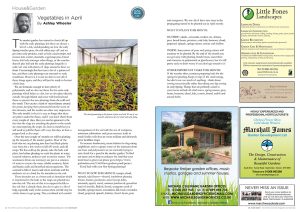
The market garden has started to slowly fill up with the early plantings, but these are always a bit of a risk, and depending on how the early Spring weather goes, the risk either pays off and we get extra early produce, such as baby salad turnips, red russian kale, rocket, mustards, sugarsnap peas, broad beans, kohl rabi amongst other things, or the weather doesn’t play ball and the early plantings languish in cold, wet soil, with plenty of slugs around to feast on them. Frustratingly this has been a bit of a pattern of late, and these early plantings can succumb to such conditions. However, it is not too late to sow all of these things again, and they will just be ready to harvest a little later.
We are fortunate enough to have plenty of polytunnels, and we also use these for the extra early plantings which helps us a lot, but we also plant directly outside through March and cover with horticultural fleece to protect the new plantings from the cold and the winds. This creates a kind of microclimate around the plants, keeping them protected from the worst of the elements, and the results are often very impressive. The only trouble is that it is easy to forget that there are plants under the fleece, and if you don’t check them every couple of days, then you can be ignorant to the fact that the slugs are attacking the plants or the weeds are outcompeting the crops. So, bear in mind that you will need to pull the fleece off every few days to have a proper look at the crops.
Over the next couple of months we will be planting up the majority of the market garden. Most of the beds that we are planting into have had black plastic over them for a few weeks to kill off weeds and old crops. We then roll up the plastic, rake the beds and plant, but before planting we soak the plants in water, seaweed solution, molasses and wormcast extract. The wormcasts (from our wormery) are put in a solution of water to extract the water soluble nutrients, fulvic and humic acids and beneficial microorganisms. The seaweed is full of macro and micro nutrients and the molasses act as a food for the microbes in the soil.
These drenches act as a boost and an inoculant which is transferred to the beds as the crops are planted out into the soil. The aim of this is to support the life in the soil that is already there, but also to give it a bit of help, especially early in the season when soil life may be a little slower to get going. This, combined with careful management of the soil with the use of composts, minimum cultivations and green manures leads to much livelier soils that are more resilient and ultimately grow healthier crops.
To increase biodiversity, create habitat for slug eating amphibians and to capture some of the rainwater from our barn and polytunnels we are currently trying to raise funds for a pond in the market garden. To find out more and to help us enhance the land that your local food is grown on please go to https://www.gofundme.com/f/trill-farm-gardens-pond-project
Good luck with your first Spring plantings!
WHAT TO SOW THIS MONTH: turnips, chard, spinach, salad leaves—chervil, buckshorn plantain, lettuce, burnet, peashoots, anise hyssop, kales, mustards, agretti, sorrel, summer purslane & goosefoot (end of month). Radish, fennel, courgettes (end of month), spring onions, cucumbers, dill, basil, coriander, chard, perpetual spinach, kalettes, french beans, peas and mangetout. We sow all of these into trays in the propagating tunnel to be planted out in April mostly.
WHAT TO PLANT THIS MONTH:
OUTSIDE: salads—mustards, rockets etc., lettuce, peas, broad beans, potatoes, early kale, beetroot, chard, perpetual spinach, spring onions, onions and shallots
INSIDE: Successions of peas and spring onions will continue to be planted. By the end of the month you can get away with planting french beans, cucumbers and tomatoes in polytunnels or glasshouses, but it’s still pretty early so don’t worry if you don’t get round to it!
OTHER IMPORTANT TASKS THIS MONTH: If the weather dries, continue preparing beds for the spring for planting. Keep on top of the seed sowing, but don’t sow too much of anything – think about sowing successionally rather than doing one big sowing in early Spring. Things that are perfectly suited to successions include all salad leaves, spring onions, peas, beans, beetroot, chard, kale, carrots, fennel, radish and annual herbs.



